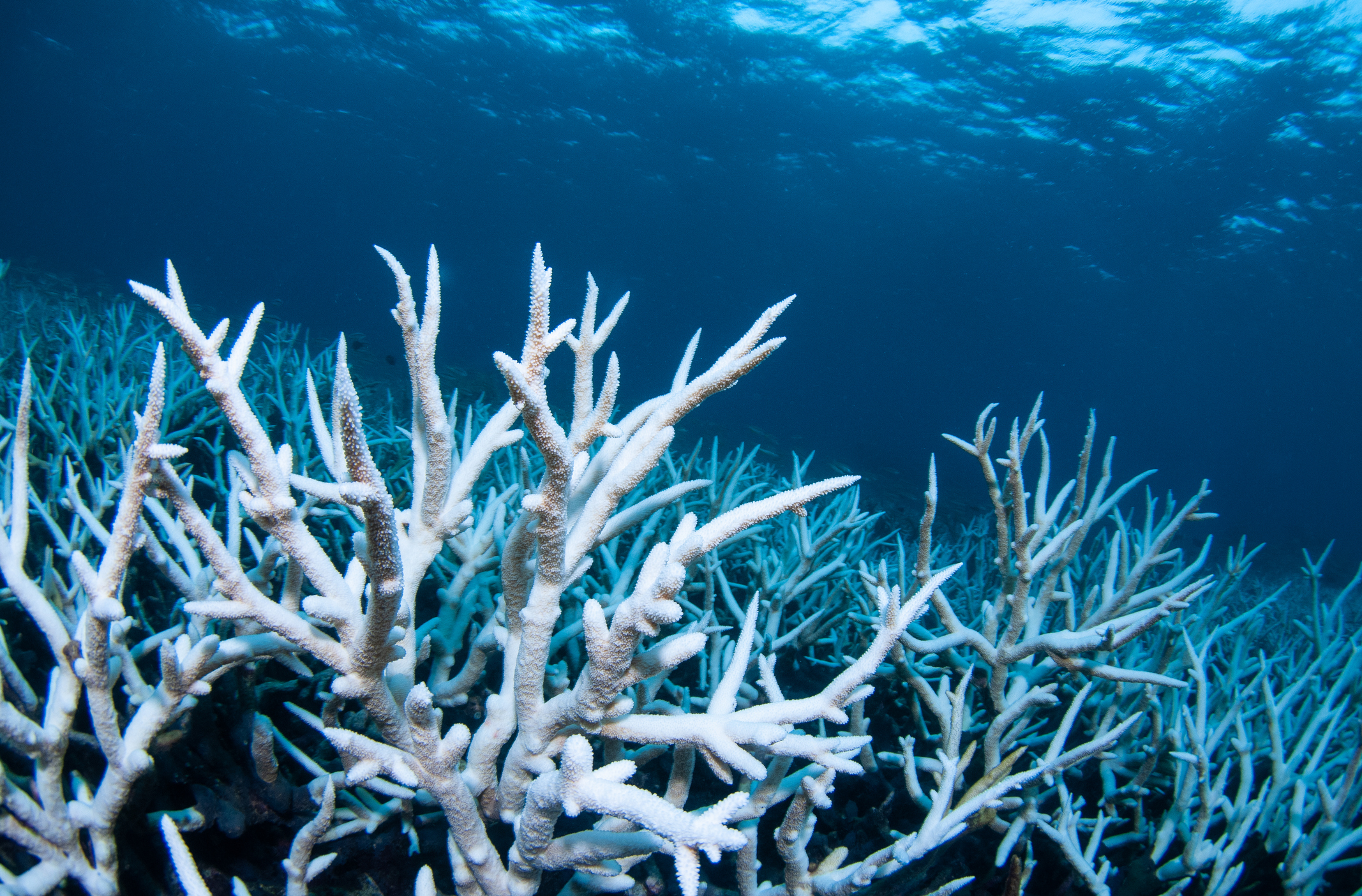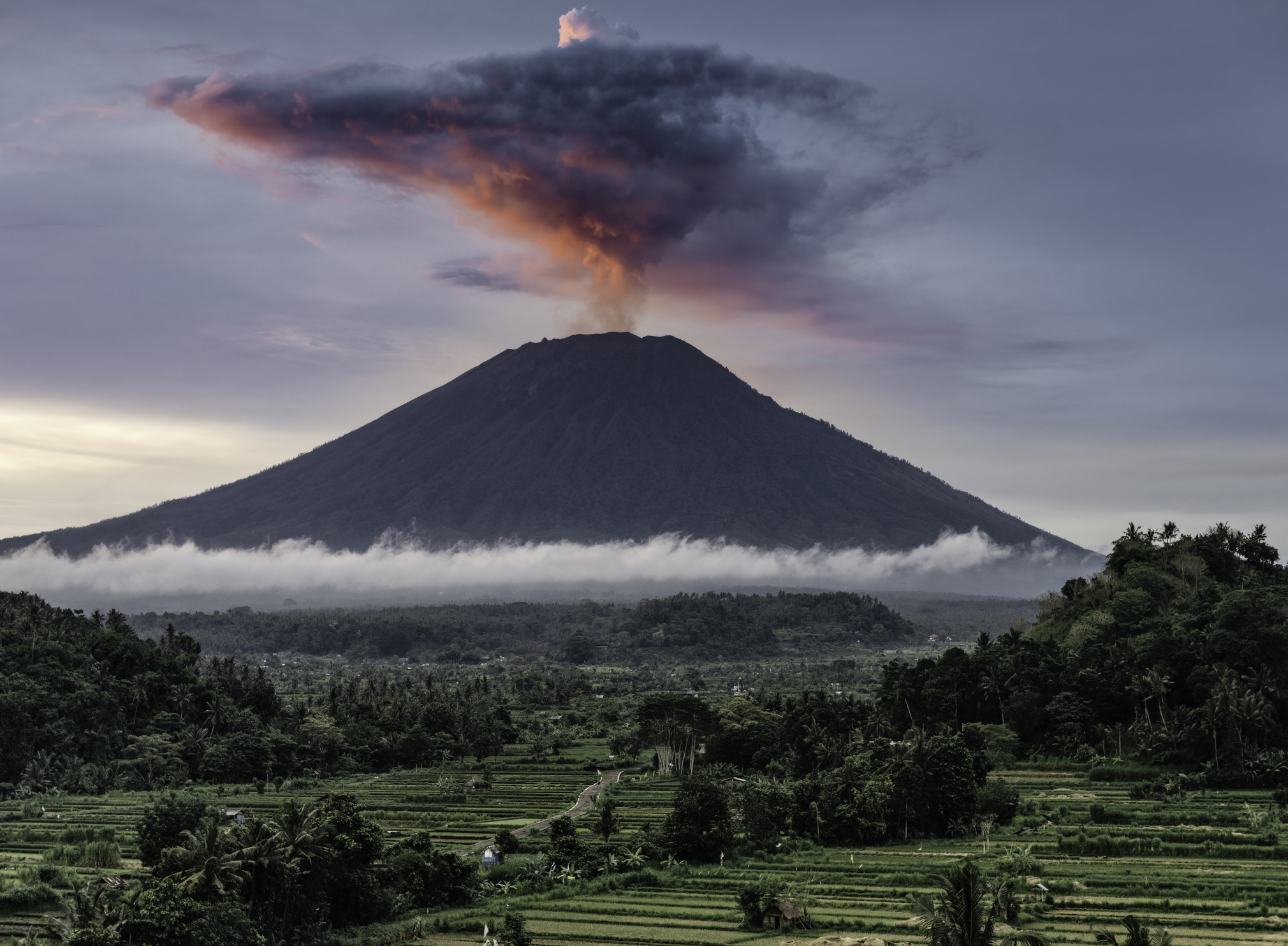
Asia, Indonesia, Bali, view of Mount Agung during eruption, at sunset, showing rice paddies in foreground, with volcanic ash plume
SRM360 Guide
Les méthodes de réflexion de la lumière solaire
Les méthodes de réflexion de la lumière solaire (MRS) – également appelées « géo-ingénierie solaire » ou « modification du rayonnement solaire » – sont un ensemble d’idées visant à réfléchir une petite fraction de la lumière solaire entrante afin de faire baisser les températures mondiales. Parmi ces différentes idées, l’une se distingue car elle semble la plus réalisable et la plus efficace, tandis qu’une autre présente un potentiel important.
Piéger la chaleur et réfléchir la lumière
La Terre réfléchit actuellement près de 30 % de la lumière solaire qui l’atteint. Si seulement 1 % supplémentaire de lumière solaire était réfléchi, cela ferait baisser les températures d’environ 1° C, ce qui changerait la donne. Ce chiffre à représente peu près la différence entre les objectifs climatiques des pays, qui oscillent entre un réchauffement de 1,5° C ou 2,0° C et les mesures qui semblent conduire le monde vers un réchauffement de 2,5° C à 3,0° C.
Les méthodes de réflexion de la lumière solaire (MRS) – ou géo-ingénierie solaire – décrivent un ensemble d’idées qui visent précisément à atteindre cet objectif.
The Earth’s energy budget
When sunlight reaches the earth, it is either reflected to space or absorbed and re-emitted as heat. Emissions of greenhouse gases, like carbon dioxide, trap heat, causing warming.
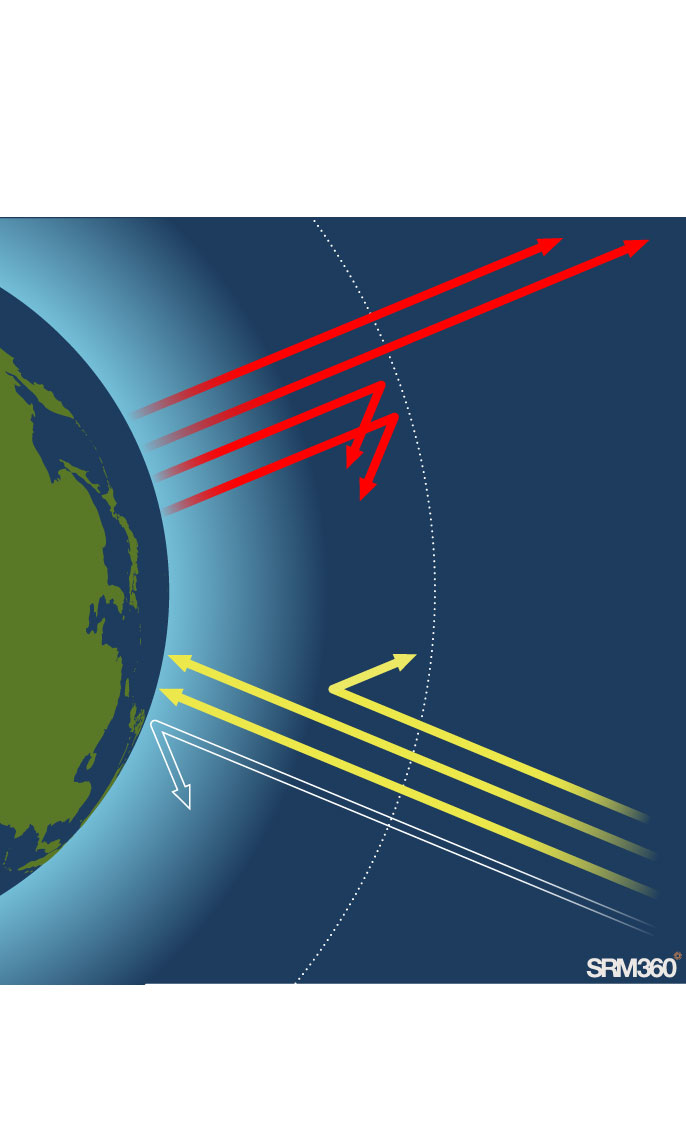
When sunlight reaches the earth, it is either reflected to space or absorbed and re-emitted as heat. Emissions of greenhouse gases, like carbon dioxide, trap heat, causing warming.
Heat reabsorbed by the atmosphere
Earth
Sunlight reflected by Earth
SRM
Sunlight reflection methods (SRM) aim to reflect some sunlight to offset that warming.
Source: SRM360
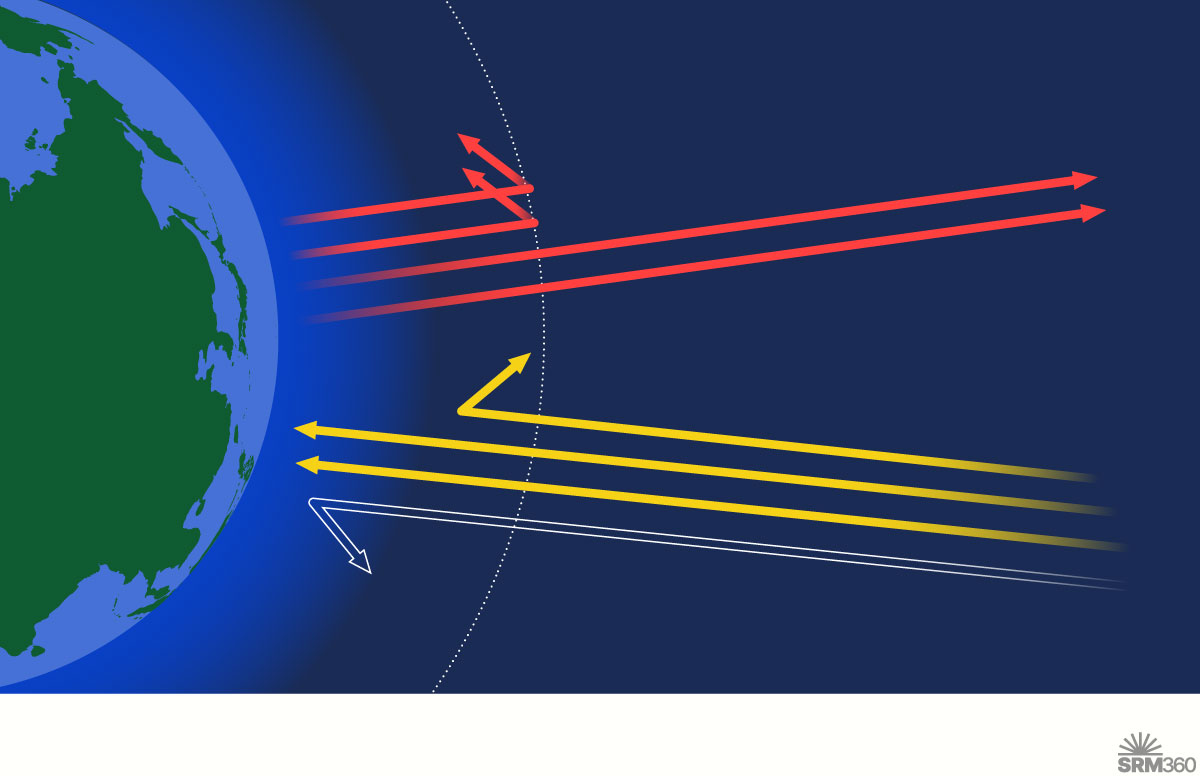
Heat reabsorbed by the atmosphere
Earth
Sunlight reflected by Earth
SRM
Sunlight reflection methods (SRM) aim to reflect some sunlight to offset that warming.
Source: SRM360
Cela ressemble à de la science-fiction – et certaines idées paraissent invraisemblables – mais si l’on examine le formidable potentiel de refroidissement qu’offrent les minuscules particules appelées « aérosols », deux idées se distinguent par leur faisabilité et leur probable efficacité.
Learn more
Injection d'aérosols dans la stratosphère (SAI)
Les grandes éruptions volcaniques, comme celle du Pinatubo en 1991 et celle du Tambora en 1815, ont créé une couche de minuscules particules de sulfate réfléchissantes dans la stratosphère, au-dessus de la plupart des nuages. En se dispersant, ces particules ont formé une fine couche sur toute la planète, qui a réfléchi une petite fraction de la lumière solaire entrante et a refroidi la Terre pendant plusieurs années.
L’injection d’aérosols dans la stratosphère (SAI) vise à imiter cet effet de refroidissement avéré en libérant de minuscules particules d’aérosols dans la stratosphère. Elles y auraient un effet refroidissant bien plus prolongé et donc bien plus important qu’elles n’en auraient dans la basse atmosphère.
Stratospheric aerosol injection
Stratospheric aerosol injection (SAI) is an idea to lower the global temperature by dispersing tiny particles in the stratosphere to reflect a small fraction of sunlight. These reflective particles would remain in the stratosphere for 1-2 years, rather than the few days they would last in the lower atmosphere, because the stratosphere is stable and dry.

SAI would be a global intervention.
Wherever particles were released in the stratosphere, strong winds would spread them out east-west around the world and then towards the poles.
Sunlight
The stable stratosphere
The stratosphere is dry and the temperature increases with height. As a result, there are very few clouds in the stratosphere and it is stable. This means particles can persist for a few years before they eventually drop into the troposphere.
Warmer air
Cooler air
The turbulent troposphere
The lowermost part of the atmosphere, the troposphere, is turbulent and humid. Particles remain in the troposphere for only a few days before they either settle to the ground or are caught up in clouds and rained out.
Warm air
Cool air
Source: SRM360

SAI would be a global intervention.
Wherever particles were released in the stratosphere, strong winds would spread them out east-west around the world and then towards the poles.
Sunlight
Warmer air
The stable stratosphere
The stratosphere is dry and the temperature increases with height. As a result, there are very few clouds in the stratosphere and it is stable. This means particles can persist for a few years before they eventually drop into the troposphere.
Cooler air
The turbulent troposphere
Warm air
The lowermost part of the atmosphere, the troposphere, is turbulent and humid. Particles remain in the troposphere for only a few days before they either settle to the ground or are caught up in clouds and rained out.
Cool air
Source: SRM360

SAI would be a global intervention.
Wherever particles were released in the stratosphere, strong winds would spread them out east-west around the world and then towards the poles.
Sunlight
The stable stratosphere
The stratosphere is dry and the temperature increases with height. As a result, there are very few clouds in the stratosphere and it is stable. This means particles can persist for a few years before they eventually drop into the troposphere.
Warmer air
Cooler air
The turbulent troposphere
The lowermost part of the atmosphere, the troposphere, is turbulent and humid. Particles remain in the troposphere for only a few days before they either settle to the ground or are caught up in clouds and rained out.
Cool air
Warm air
Source: SRM360
Si elle utilisait des centaines d’avions dédiés transportant des millions de tonnes de sulfate ou d’autres particules vers la stratosphère, la géo-ingénierie opérée via la SAI pourrait faire baisser les températures mondiales d’un, voire de plusieurs degrés Celsius. Bien que des incertitudes demeurent, il ne fait guère de doute que cela pourrait avoir un effet de refroidissement considérable.
En faisant baisser les températures mondiales, la SAI pourrait atténuer bon nombre de risques climatiques, mais pas tous. Elle modifierait les régimes des précipitations, entraînant des changements plus importants à certains endroits, ce qui aurait des effets secondaires indésirables. Elle pourrait augmenter légèrement les pluies acides, rendre le ciel un peu plus brumeux et retarder de quelques décennies la lente récupération du trou dans la couche d’ozone.
Learn more
Éclaircissement des nuages marins (MCB selon l'anglais)
Des « traînées de condensation de navires » se forment dans certaines zones océaniques lorsque des navires polluants passent sous des nuages bas. Les minuscules particules de pollution émises par ces navires sont comme des semences qui créent de nouvelles gouttelettes de nuages, ce qui favorise la formation de nuages ou éclaircit les nuages existants.
En raison de la modification des normes de pollution qui s’appliquent aux navires depuis 2020, les traînées de condensation de navires sont moins courantes et les nuages océaniques situés près des routes maritimes fréquentées sont moins réfléchissants. Ces efforts de dépollution seraient en partie responsables de la hausse des températures mondiales.
L’éclaircissement des nuages marins (MCB) vise à produire un effet similaire sur les nuages sans provoquer les effets de la pollution atmosphérique. En pulvérisant de l’eau de mer depuis des navires, on espère produire un effet d’éclaircissement des nuages.
Marine cloud brightening
Marine cloud brightening (MCB) is an idea to enhance the reflectivity of low-lying clouds over the oceans. MCB may be able to produce a large regional cooling effect, but the uneven cooling may lead to large shifts in global rainfall patterns.
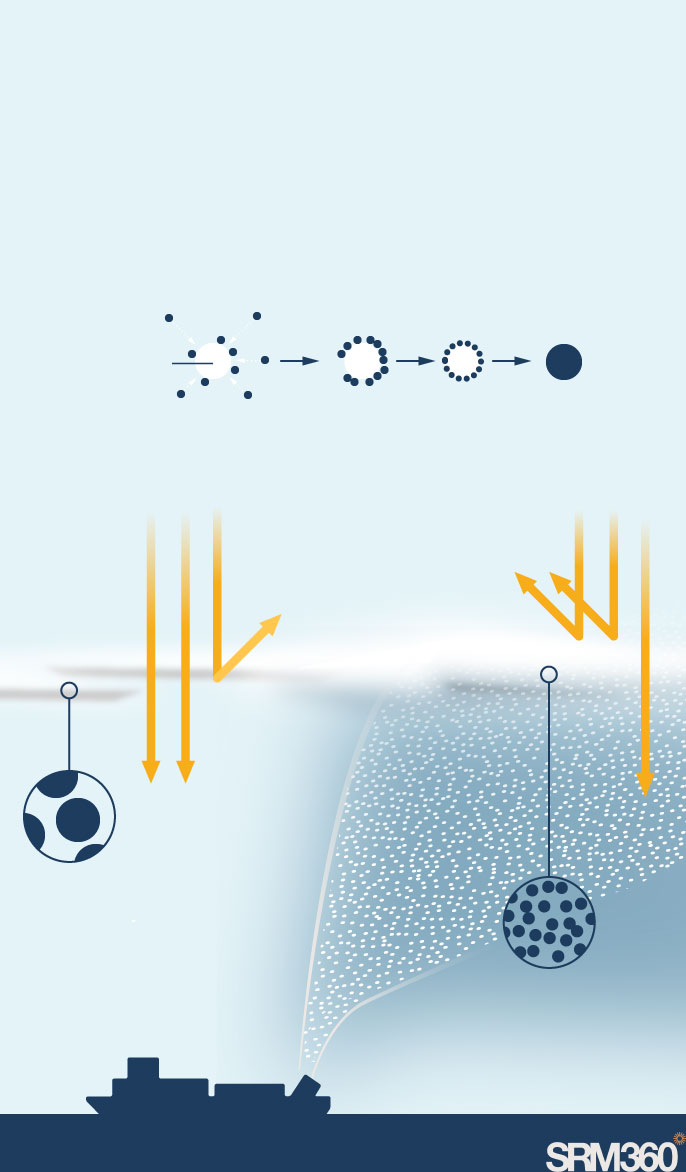
Ships would spray tiny sea salt particles into the clouds. These particles are so small they stay suspended in the air and act as seeds for forming new, smaller cloud droplets.
Water molecules condense around the particle to form a cloud droplet
Sea-salt particle
Droplet
Water molecule
Clouds with fewer, larger cloud droplets reflect less light
More, smaller droplets reflect more light.
Source: SRM360.org
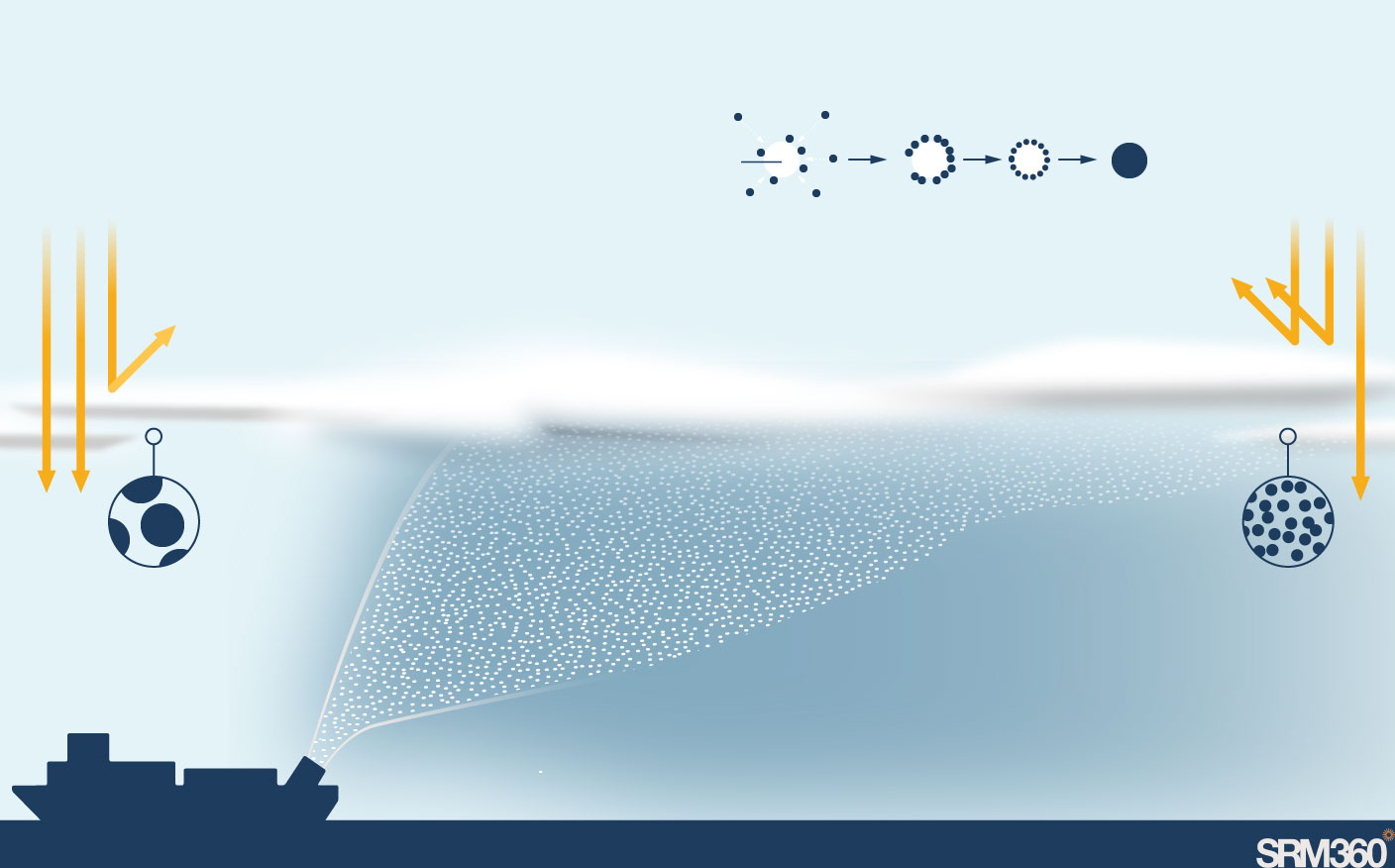
Ships would spray tiny sea salt particles into the clouds. These particles are so small they stay suspended in the air and act as seeds for forming new, smaller cloud droplets.
Water molecules condense around the particle to form a cloud droplet
Sea-salt particle
Droplet
Water molecule
More, smaller droplets reflect more light.
Clouds with fewer, larger cloud droplets reflect less light
Source: SRM360.org
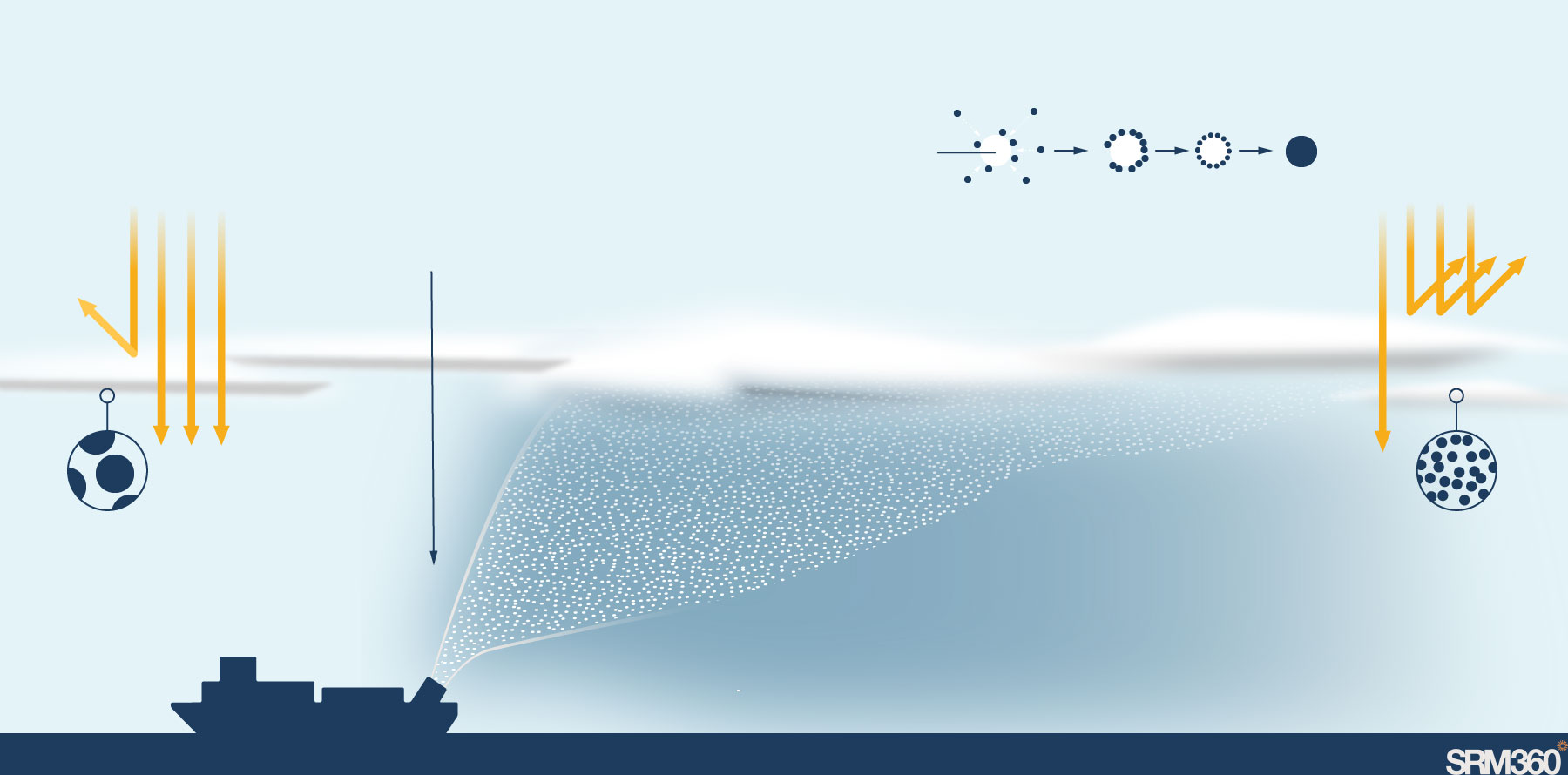
Ships would spray tiny sea salt particles into the clouds. These particles are so small they stay suspended in the air and act as seeds for forming new, smaller cloud droplets.
Water molecules condense around the particle to form a cloud droplet
Sea-salt particle
Droplet
Water molecule
Clouds with fewer, larger cloud droplets reflect less light
More, smaller droplets reflect more light.
Source: SRM360.org
Bien que cette idée puisse fonctionner en principe, les ingénieurs n’ont pas encore conçu de pulvérisateurs de sel marin suffisamment efficaces pour faire partie du déploiement, et les effets des particules sur les nuages restent très incertains. En réalité, ces interactions entre les aérosols et les nuages sont l’une des plus grandes incertitudes de la science du climat.
C’est pourquoi une équipe australienne mène des expériences sur le terrain depuis 2020 et que plusieurs autres équipes de recherche travaillent à l’élaboration de leurs propres projets d’expériences sur le terrain.
Learn more
Autres méthodes de réflexion de la lumière solaire
Si ce sont la SAI et le MCB qui retiennent le plus l’attention des chercheurs, il existe plusieurs autres pistes en termes de MRS.
Les MRS spatiales consisteraient à placer des matériaux entre la Terre et le soleil afin de dévier la lumière avant qu’elle n’atteigne la Terre. Mais cela aurait un coût prohibitif, du moins lors des prochaines décennies.
L’amincissement des cirrus aurait pour but de réduire l’effet de piégeage de la chaleur qu’exercent les cirrus élevés et clairsemés. Ajouter le bon type de particules pourrait amincir ces nuages, mais le potentiel et l’efficacité de cette méthode restent très incertains.
Il existe aussi quelques pistes pour éclaircir les surfaces, comme par exemple : la création de cultures un peu plus réfléchissantes, la construction à l’aide de matériaux plus clairs, ou encore l’éclaircissement et l’épaississement de la banquise. Ces idées pourraient atténuer les effets locaux, mais aucune d’entre elles ne saurait être appliquée à une échelle suffisante pour refroidir significativement toute la planète.
An overview of sunlight reflection methods
Sunlight reflection methods (SRM) are hypothetical approaches to lower global temperatures by increasing the amount of sunlight reflected to space.
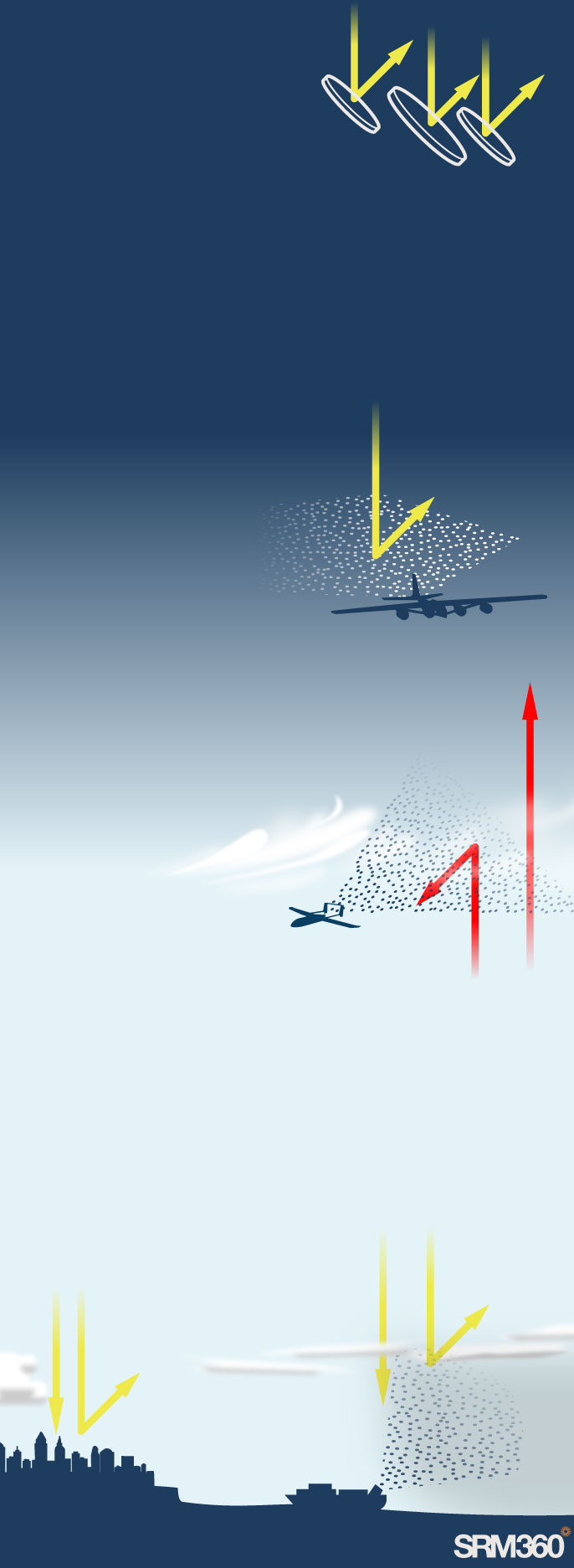
Space-based SRM
Reflective material between the earth and sun could scatter light, but delivery would be extremely costly.
Stratospheric aerosol injection (SAI)
Tiny particles released in the stratosphere could reflect a small fraction of sunlight, producing a global cooling.
Sunlight
Cirrus cloud
thinning (CCT)
Seeding might thin cirrus clouds, allowing more heat to escape to space.
Heat
Surface albedo modification
Brighter surfaces could reflect more sunlight, but global cooling potential is limited.
Marine cloud brightening (MCB)
Sea-salt particles could be sprayed from ships to enhance the reflectivity of low-lying clouds.
Source: SRM360.org

Space-based SRM
Reflective material between the earth and sun could scatter light, but delivery would be extremely costly.
Sunlight
Stratospheric aerosol injection (SAI)
Tiny particles released in the stratosphere could reflect a small fraction of sunlight, producing a global cooling.
Cirrus cloud
thinning (CCT)
Seeding might thin cirrus clouds, allowing more heat to escape to space.
Heat
Surface albedo modification
Brighter surfaces could reflect more sunlight, but global cooling potential is limited.
Marine cloud brightening (MCB)
Sea-salt particles could be sprayed from ships to enhance the reflectivity of low-lying clouds.
Source: SRM360.org
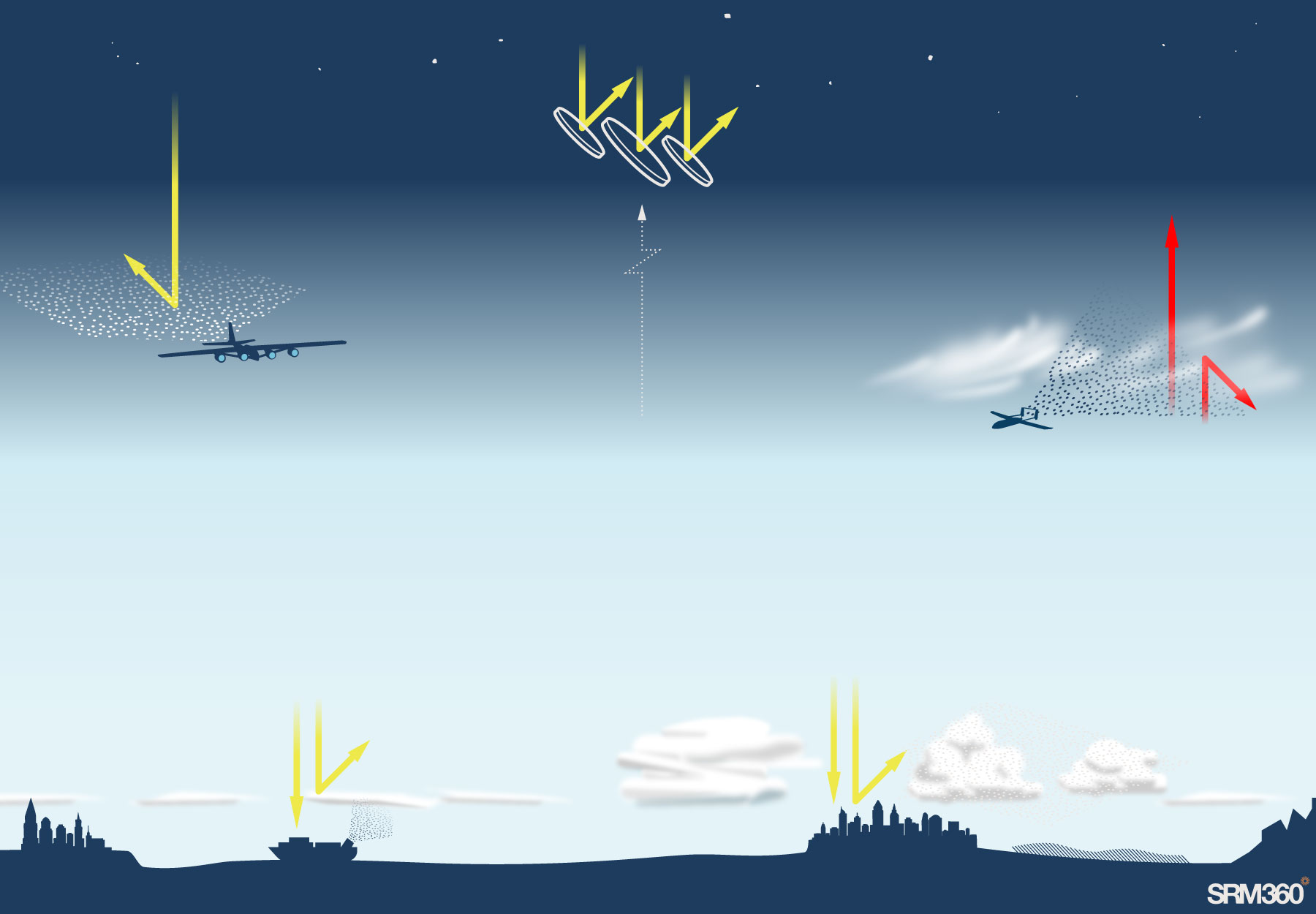
Sunlight
Heat
Marine cloud brightening (MCB)
Sea-salt particles could be sprayed from ships to enhance the reflectivity of low-lying clouds.
Space-based SRM
Reflective material between the earth and sun could scatter light, but delivery would be extremely costly.
Surface albedo modification
Brighter surfaces could reflect more sunlight, but global cooling potential is limited.
Cirrus cloud
thinning (CCT)
Seeding might thin cirrus clouds, allowing more heat to escape to space.
Stratospheric aerosol injection (SAI)
Tiny particles released in the stratosphere could reflect a small fraction of sunlight, producing a global cooling.
Source: SRM360.org
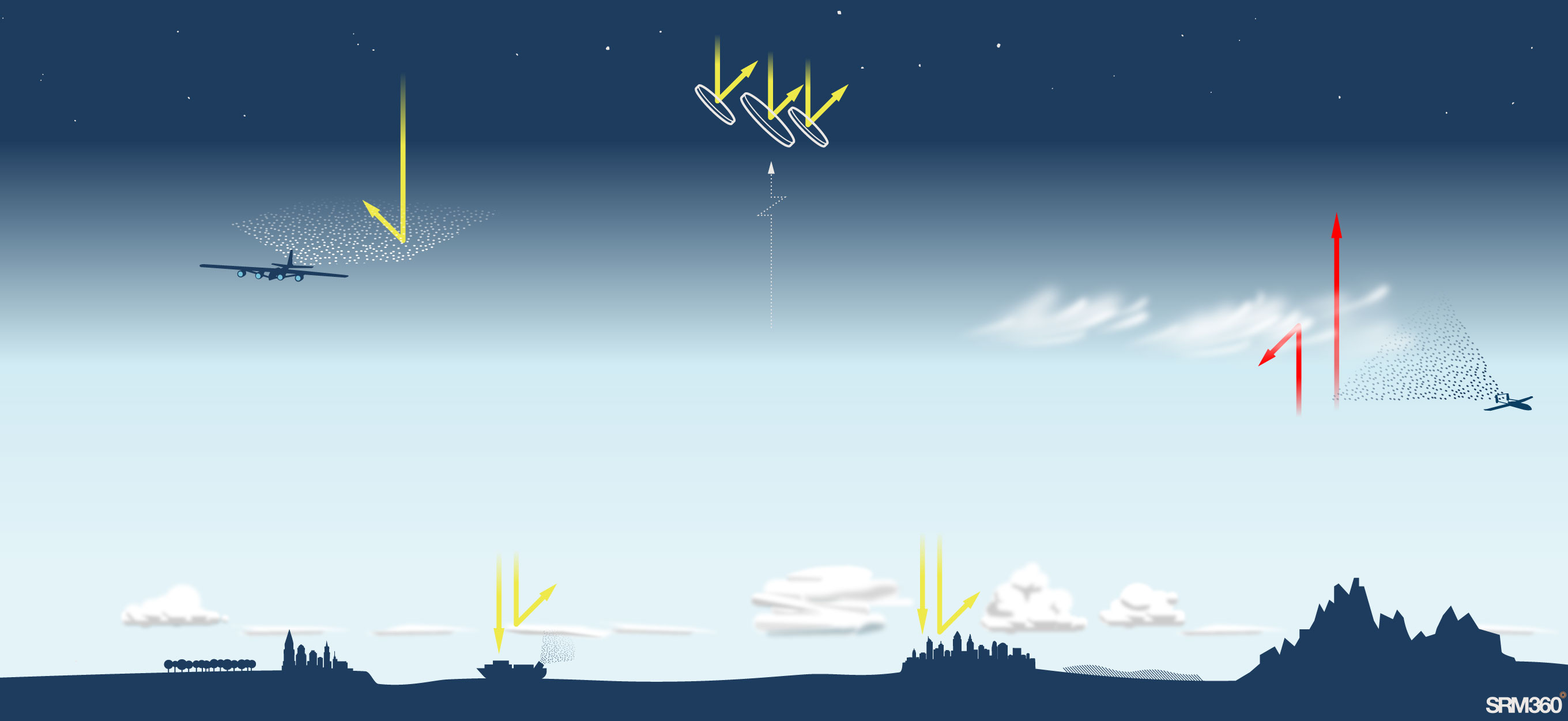
Sunlight
Heat
Marine cloud brightening (MCB)
Sea-salt particles could be sprayed from ships to enhance the reflectivity of low-lying clouds.
Space-based SRM
Reflective material between the earth and sun could scatter light, but delivery would be extremely costly.
Surface albedo modification
Brighter surfaces could reflect more sunlight, but global cooling potential is limited.
Cirrus cloud
thinning (CCT)
Seeding might thin cirrus clouds, allowing more heat to escape to space.
Stratospheric aerosol injection (SAI)
Tiny particles released in the stratosphere could reflect a small fraction of sunlight, producing a global cooling.
Source: SRM360.org
Learn more
Les MRS peuvent-elles contribuer à la lutte contre le changement climatique ?
La réduction des émissions de gaz à effet de serre est et restera la principale stratégie de lutte contre le changement climatique. L’élimination du carbone déjà présent dans l’atmosphère et l’adaptation sont également essentielles.
Les MRS sont envisagées comme un outil supplémentaire à utiliser parallèlement à ces autres stratégies, car elles offrent un moyen de faire baisser les températures et de limiter bon nombre des effets néfastes du changement climatique. Ces méthodes s’accompagneraient toutefois de nouveaux risques et incertitudes et soulèveraient de sérieuses questions éthiques et politiques.
Emissions cuts, carbon removal, and SRM
Emissions cuts and carbon dioxide removal (CDR) tackle the root cause of climate change, and sunlight reflection methods (SRM) could limit warming while they work.
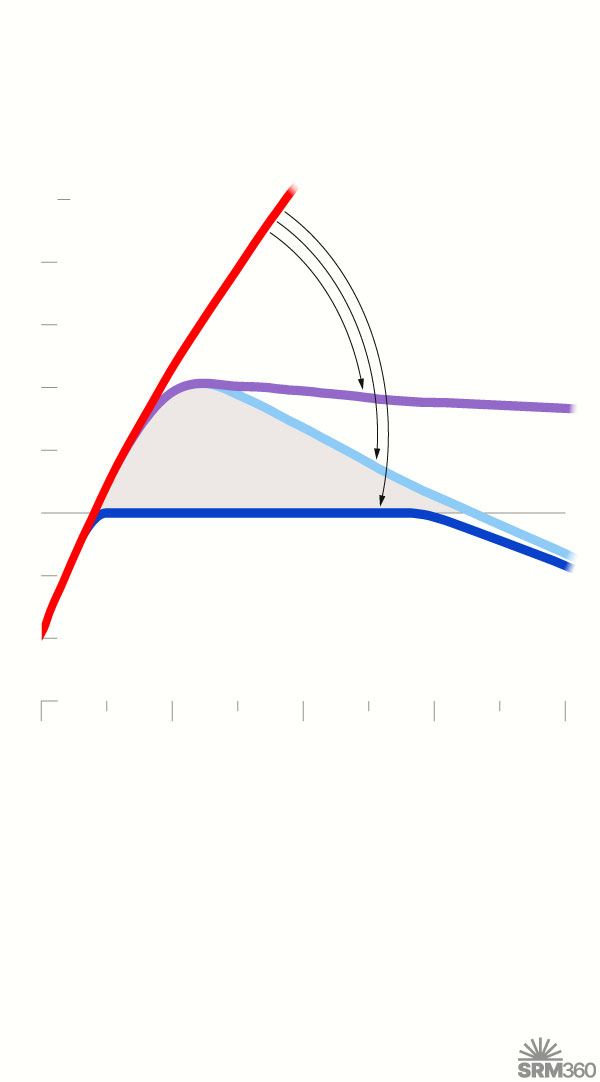
GLOBAL TEMPERATURE INCREASE
No emissions cuts
Temperatures would continue to rise.
Cut emissions
Eliminating CO2 emissions would stop global warming, but not reverse it.
4.0°C
3.5
3.0
2.5
2.0
1.5
1.0
0.5
0
2000
2100
2200
2300
2400
Reflect sunlight
SRM could offset global warming while emissions cuts and CDR work.
Remove carbon
CDR could then slowly lower temperatures.
Source: Based on Boselius et al. (2025), Oxford Open Climate Change
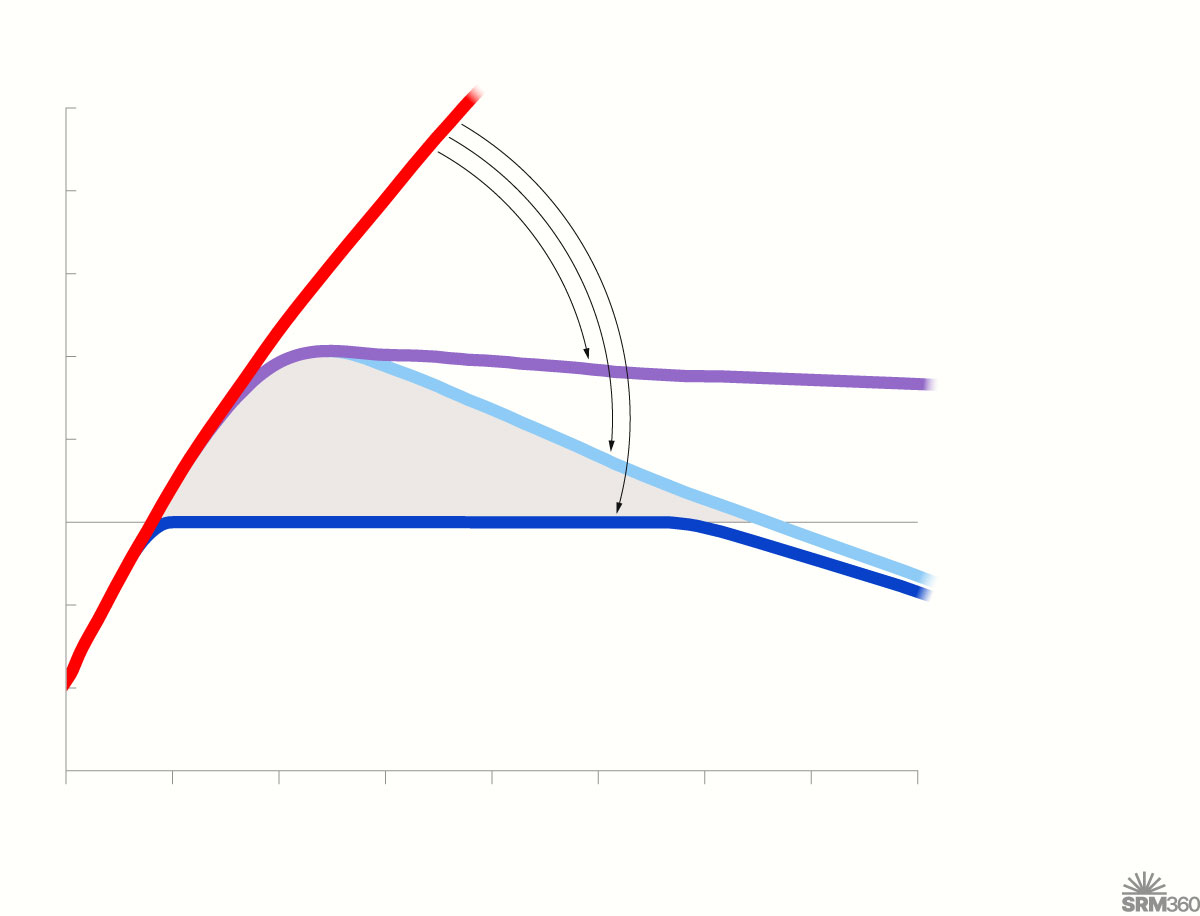
GLOBAL TEMPERATURE INCREASE
4.0°C
No emissions cuts
Temperatures would continue to rise.
CUT EMISSIONS
Eliminating CO2 emissions would stop global warming, but not reverse it.
3.5
3.0
2.5
2.0
REMOVE CARBON
CDR could then slowly lower temperatures.
1.5
REFLECT SUNLIGHT
SRM could offset global warming while emissions cuts and CDR work.
1.0
0.5
2000
2050
2100
2150
2200
2250
2300
2350
2400
Source: Based on Boselius et al. (2025), Oxford Open Climate Change
